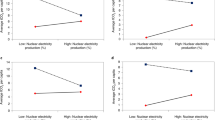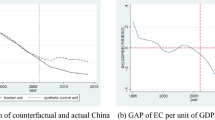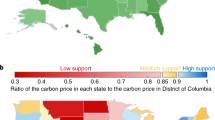Abstract
President Obama’s landmark initiative to reduce the CO2 emissions of existing power plants, the nation’s largest source of greenhouse gas (GHG) pollutants, depends heavily on states and their ability to devise policies that meet the goals set by the Environmental Protection Agency (EPA). Under the EPA’s proposed Clean Power Plan, states will be responsible for cutting power plants’ carbon pollution 30% from 2005 levels by 2030. States have already adopted several policies to reduce the electricity sector’s climate impact. Some of these policies focus on reducing power plants’ CO2 emissions, and others address this outcome in a more roundabout fashion by encouraging energy efficiency and renewable energy1. However, it remains unclear which, if any, of these direct and indirect strategies actually mitigate plants’ emissions because scholars have yet to test their effects using plant-level emission data. Here we use a newly released data source to determine whether states’ policies significantly shape individual power plants’ CO2 emissions. Findings reveal that certain types of direct strategy (emission caps and GHG targets) and indirect ones (public benefit funds and electric decoupling) lower plants’ emissions and thus are viable building blocks of a federal climate regime.
This is a preview of subscription content, access via your institution
Access options
Subscribe to this journal
Receive 12 print issues and online access
$209.00 per year
only $17.42 per issue
Buy this article
- Purchase on Springer Link
- Instant access to full article PDF
Prices may be subject to local taxes which are calculated during checkout
Similar content being viewed by others
References
Carley, S. The era of state energy policy innovation: A review of policy instruments. Rev. Policy Res. 28, 265–294 (2011).
Dunlap, R. & McCright, A. in The Oxford Handbook of Climate Change and Society (eds Dryzek, J., Norgaard, R. & Schlosberg, D.) 144–160 (Oxford Univ. Press, 2011).
Environmental Defense Fund, The Legal Foundation for Strong, Flexible and Cost-Effective Carbon Pollution Standards for Existing Power Plants (Environmental Defense Fund, 2013) http://www.edf.org/sites/default/files/111-clean_air_act-strong_flexible_cost-effective_carbon_pollution_standards_for_existing_power_plants.pdf
Bushnell, J., Peterman, C. & Wolfram, C. Local solutions to global problems: Climate change policies and regulatory jurisdiction. Rev. Environ. Econ. Policy 2, 175–193 (2008).
Doremus, H. & Hanemann, M. Of babies and bathwater: Why the Clean Air Act’s cooperative federalism framework is useful for addressing global warming. Ariz. L. Rev. 50, 799–834 (2008).
Rabe, B. G. States on steroids: The intergovernmental odyssey of American climate policy. Rev. Policy Res. 25, 105–128 (2008).
Pew Center on Global Climate Change, Climate Change 101: State Action (Pew Center on Global Climate Change, 2011).
Rabe, B. in Environmental Policy: New Directions for the Twenty-first Century (eds Vig, N. & Kraft, M.) 30–53 (CQ Press/Sage, 2010).
Michaels, R. National renewable portfolio standard: Smart policy or misguided gesture? Energy Law J. 29, 79–119 (2008).
Victor, D. G., House, J. C. & Joy, S. A Madisonian approach to climate policy. Science 309, 1820–1821 (2005).
Lutsey, N. & Sperling, D. America’s bottom-up climate change mitigation strategy. Energy Policy 36, 673–685 (2008).
Lyon, T. P. & Yin, H. T. Why do states adopt renewable portfolio standards? An empirical investigation. Energy J. 31, 133–157 (2010).
Jenner, S., Chan, G., Frankenberger, R. & Gabel, M. What drives states to support renewable energy? Energy J. 33, 1–12 (2012).
Matisoff, D. The adoption of state climate change policies and renewable portfolio standards: regional diffusion or internal determinants? Rev. Policy Res. 25, 527–546 (2008).
Rabe, B. Race to the top: the expanding role of U. S. state renewable portfolio standards. Sustain. Dev. Law Policy 7, 10–16 (2007).
National Research Council, Changing Climate: Report of the Carbon Dioxide Assessment Committee (Nat. Academy Press, 1983).
Nemet, G. & Baker, E. Demand subsidies versus R&D: Comparing the uncertain impacts of policy on a pre-commercial low-carbon energy technology. Energy J. 30, 49–80 (2009).
Gouldner, L. & Schneider, S. Induced technological change and the attractiveness of CO2 abatement technology. Resour. Energy Econ. 21, 211–253 (1999).
Carley, S. State renewable energy electricity policies: An empirical evaluation of effectiveness. Energy Policy 37, 3071–3081 (2009).
National Renewable Energy Laboratory Evaluating Renewable Portfolio Standards and Carbon Cap Scenarios in the U.S. Electric Sector (NREL/TP-6A2-48258, 2010).
Prasad, M. & Munch, S. State-level renewable electricity policies and reductions in carbon emissions. Energy Policy 45, 237–242 (2012).
Freudenburg, W. Privileged access, privileged accounts: Toward a socially structured theory of resources and discourses. Soc. Forces 84, 89–114 (2005).
Grant, D., Jorgenson, A. & Longhofer, W. Targeting extreme polluters: An alternative approach to reducing energy-related CO2 emissions. J. Environ. Stud. Sci. 3, 376–380 (2013).
Joskow, P. & Schmalensee, R. The performance of coal-burning electric generating units in the United States: 1960–1980. J. Appl. Econom. 2, 85–109 (1987).
US Energy Information Administration, U.S. Energy-Related Carbon Emissions 2010 (US Department of Energy, 2011).
U.S. Environmental Protection Agency, Available and Emerging Technologies for Reducing Greenhouse Gas Emissions from Coal-Fired Electric Generating Units (US Environmental Protection Agency, 2010).
Selin, H. & VanDeveer, S. in Changing Climates in North American Politics: Institutions, Policymaking, and Multilevel Governance (eds Selin, H. & VanDeveer, S.) 111–136 (MIT Press, 2009).
Gunningham, N. & Grabosky, P. Smart Regulation: Designing Environmental Policy (Clarendon Press, 1998).
Goulder, L. H. & Stavins, R. N. Interactions Between State and Federal Climate Change Policies (National Bureau of Economic Research, 2010) http://www.nber.org/papers/w16123
Halaby, C. Panel models in sociological research: Theory into practice. Ann. Rev. Sociol. 30, 507–544 (2004).
Acknowledgements
This study is supported by a grant from the National Science Foundation (award number 1123262). The authors thank D. Kaffine, P. Komor, C. Jenkins, W. Longhofer, R. Masters and F. Pampel for valuable feedback on our paper.
Author information
Authors and Affiliations
Contributions
D.G. conceived of the study, performed data analysis, and wrote the text. K.B. and K.R. conducted data collection and helped to write and edit the manuscript.
Corresponding author
Ethics declarations
Competing interests
The authors declare no competing financial interests.
Supplementary information
Rights and permissions
About this article
Cite this article
Grant, D., Bergstrand, K. & Running, K. Effectiveness of US state policies in reducing CO2 emissions from power plants. Nature Clim Change 4, 977–982 (2014). https://doi.org/10.1038/nclimate2385
Received:
Accepted:
Published:
Issue Date:
DOI: https://doi.org/10.1038/nclimate2385
This article is cited by
-
Attributing agnostically detected large reductions in road CO2 emissions to policy mixes
Nature Energy (2022)
-
Climate policy conflict in the U.S. states: a critical review and way forward
Climatic Change (2022)
-
The potential of coupled carbon storage and geothermal extraction in a CO2-enhanced geothermal system: a review
Geothermal Energy (2020)
-
Governmental Communication of Climate Change Risk and Efficacy: Moving Audiences Toward “Danger Control”
Environmental Management (2020)
-
Effectiveness of state climate and energy policies in reducing power-sector CO2 emissions
Nature Climate Change (2017)



